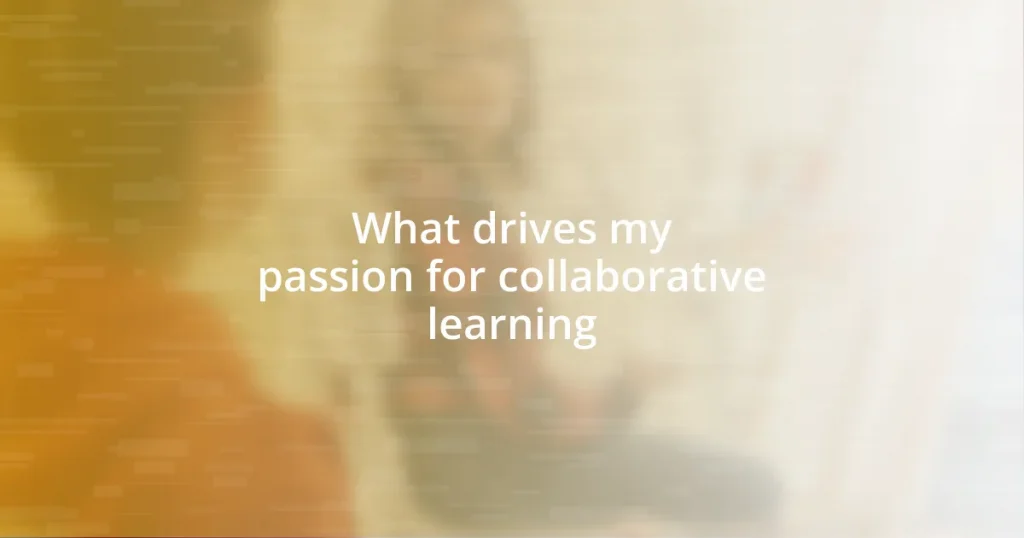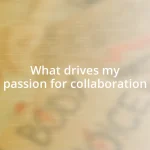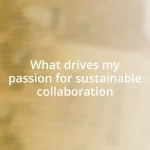Key takeaways:
- Collaborative learning enhances critical thinking, social skills, and emotional support through shared experiences and diverse perspectives.
- Effective collaboration is influenced by factors such as group composition, communication skills, and trust, which facilitate enriched discussions.
- Overcoming challenges like differing work ethics and conflicting ideas can improve team dynamics and strengthen relationships.
- The future of collaborative learning will focus on technology integration and inclusivity, promoting diverse perspectives and personalized learning experiences.

Understanding collaborative learning
Collaborative learning is a dynamic approach where individuals work together, sharing knowledge and experiences to achieve common goals. I remember one project in college where my group was tasked with developing a presentation. It wasn’t just about dividing the work; it was about bouncing ideas off each other, building on those ideas, and collectively growing. Have you ever felt that spark when someone adds to your thoughts and suddenly, a simple idea turns into something brilliant?
At its core, collaborative learning fosters a sense of community and connection. I vividly recall the energetic atmosphere in a workshop where students from diverse backgrounds came together to solve a real-world problem. The joy of exchanging different perspectives opened my eyes to solutions I wouldn’t have considered on my own. Isn’t it fascinating how collaboration can change our understanding and enhance creativity?
When we engage in collaborative learning, we’re not merely sharing tasks; we’re cultivating relationships and enhancing our emotional intelligence. I often find that the discussions we have while working together deepen my insights and challenge my assumptions. How often have you left a group session feeling not just smarter, but more connected to your peers? It’s in these moments that I realize collaborative learning is not just an educational tool—it’s a profound experience that shapes who we are.
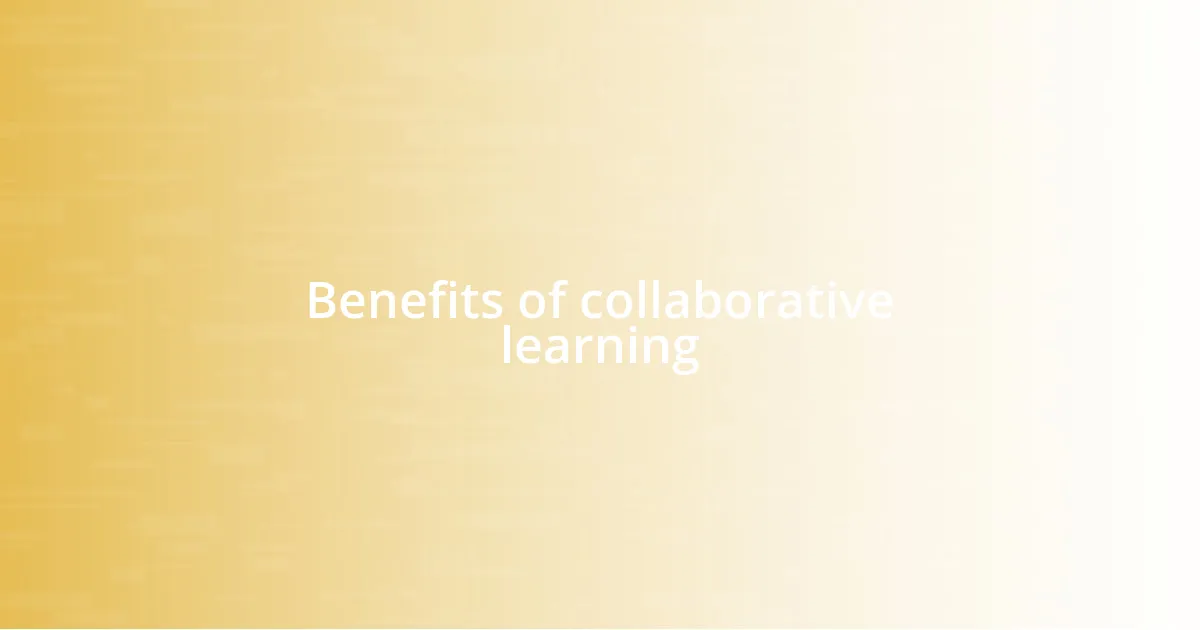
Benefits of collaborative learning
Collaborative learning brings a plethora of benefits that extend beyond traditional educational formats. One significant advantage is the enhancement of critical thinking skills. When I was part of a community project team, we often found ourselves grappling with complex issues, and I noticed how discussing our diverse viewpoints forced us to think critically and make more informed decisions. It taught me that collaboration isn’t just about working together, but about sharpening our analytical abilities through dialogue.
Moreover, the social skills developed in collaborative learning are invaluable. I recall participating in a group where we had to navigate differing opinions. The experience taught me patience and empathy, as I learned to appreciate others’ perspectives. This not only improved our group dynamics but also prepared me for real-world interactions, showcasing the importance of those soft skills in both personal and professional spheres.
Finally, the emotional support gained from working collaboratively can’t be underestimated. There have been times when I felt overwhelmed by challenges, but being part of a supportive group lifted my spirits. Sharing struggles with peers created an environment of trust, allowing us to encourage and motivate one another. It’s amazing how collaboration cultivates resilience and strengthens our emotional well-being.
| Benefit | Description |
|---|---|
| Enhanced Critical Thinking | Engaging in discussions fosters deeper analysis and informed decision-making. |
| Improved Social Skills | Collaboration cultivates empathy and patience through understanding diverse perspectives. |
| Emotional Support | Working with others creates a sense of trust and community that provides encouragement. |
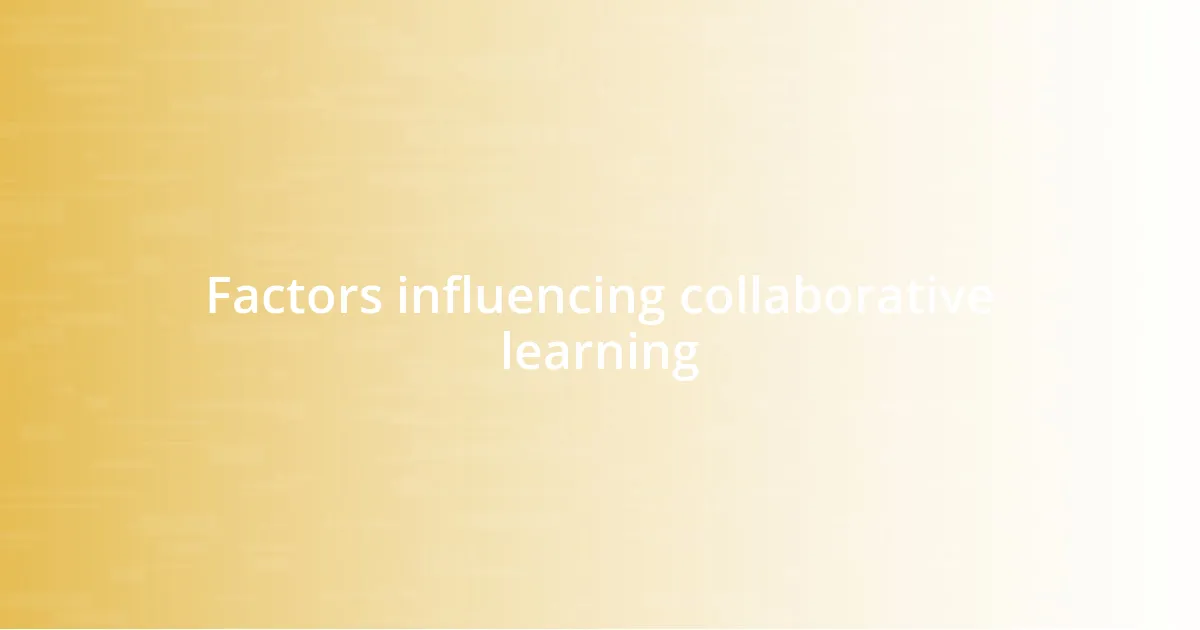
Factors influencing collaborative learning
Collaborative learning is influenced by several factors that can significantly enhance or hinder the process. One such factor is the diversity of group members. I remember a study group I joined where each participant hailed from a different discipline. Their unique approaches sparked lively debates and creative problem-solving. We not only exchanged knowledge but also gained insights into how varied perspectives can lead to richer discussions.
- Group Composition: A mix of backgrounds and skills fosters creativity and innovation.
- Communication Skills: Open and effective dialogue is crucial for expressing ideas and understanding others.
- Trust: A safe environment allows sharing without fear of judgement, enhancing cooperation.
Another key influence is the motivation of participants. During a team project, I noticed that my enthusiasm was contagious, encouraging others to share their ideas more freely. When each member feels invested in the outcome, collaboration transforms into a shared journey, making the process enjoyable and meaningful.
- Shared Goals: Clear objectives unite team members and align efforts.
- Peer Support: Encouragement from peers boosts confidence, leading to a more engaged learning environment.
- Facilitated Learning: The role of a proactive facilitator can provide direction and nurture participation.
These factors serve as the backbone of effective collaborative learning, creating an environment where individuals not only contribute but also thrive together.
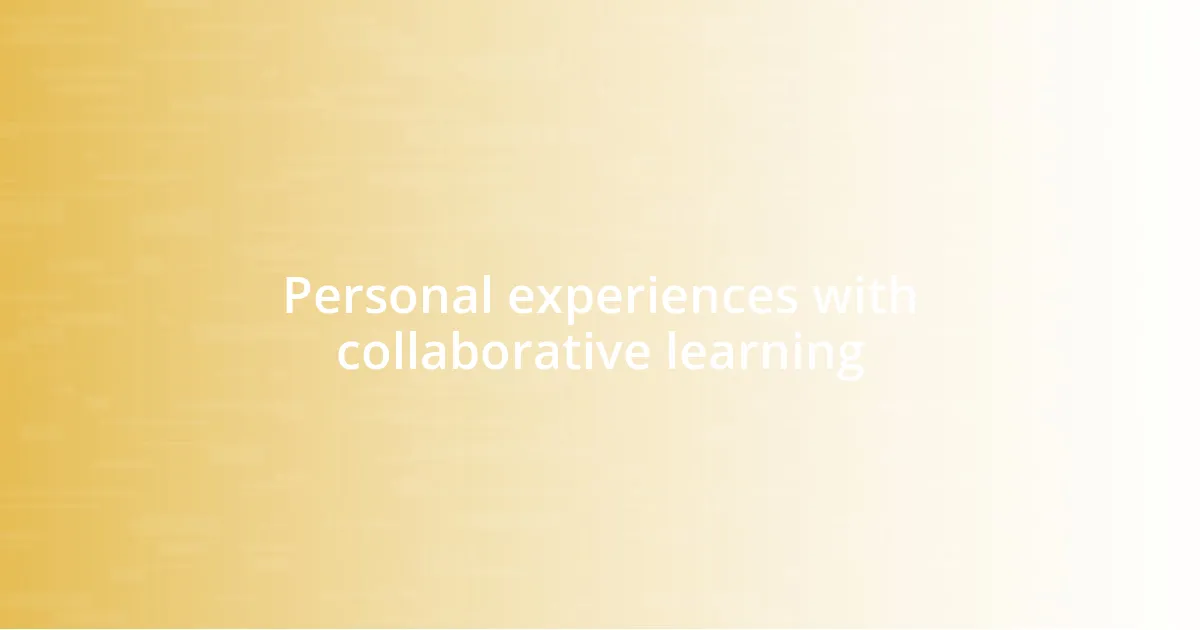
Personal experiences with collaborative learning
I vividly remember my first experience with collaborative learning during a workshop on community engagement. We were assigned to create a proposal for a local charity, and I was initially apprehensive about sharing my ideas. However, as we began to brainstorm, the atmosphere shifted. Everyone eagerly contributed, and that allowed me to express my thoughts without fear. I realized that collaboration doesn’t just diminish the weight of individual responsibility; it amplifies inspiration through shared creativity.
Another impactful moment happened during a group project in my graduate studies. My team and I faced a daunting research topic. Feeling overwhelmed, I admitted my struggles during one of our meetings. To my surprise, several teammates shared similar sentiments. This mutual vulnerability fostered a deeper bond and allowed us to support one another emotionally. Have you ever felt that sense of camaraderie? It’s remarkable how shared challenges can turn into a source of strength and fuel our motivation.
Lastly, I think back to a group discussion in an online course I took. The variety of opinions was initially challenging, leading to some heated exchanges. Yet, as we navigated our differences, I learned the value of patience and active listening. Each of us brought unique perspectives shaped by our own experiences, which ultimately enriched our understanding. Isn’t it fascinating how uncomfortable moments can lead to profound insights and growth in collaborative settings?
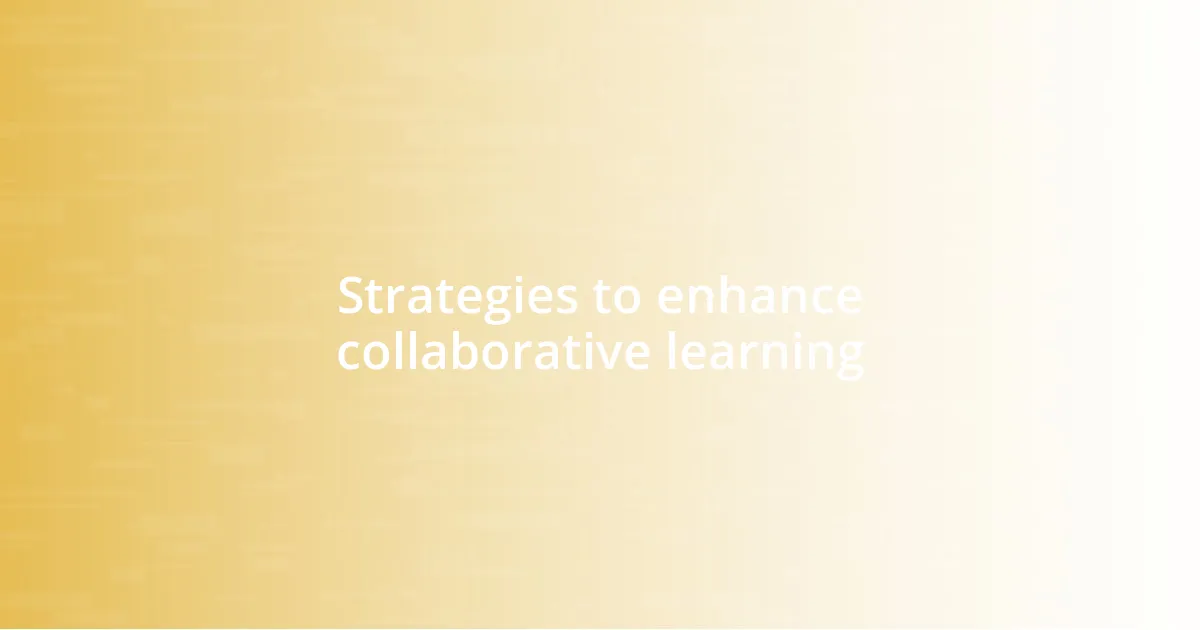
Strategies to enhance collaborative learning
One strategy I’ve found effective in enhancing collaborative learning is setting clear roles within the group. During a project I worked on, we detailed individual responsibilities based on our strengths and expertise. This not only clarified expectations but also allowed everyone to shine in their areas, creating a sense of accountability and camaraderie. Who doesn’t feel more motivated when they know their unique contributions are valued?
Another approach revolves around fostering open communication. In my experience, establishing ground rules for discussions, such as active listening and respectful feedback, can make a significant difference. I once participated in a workshop that encouraged participants to summarize others’ points before sharing their own. This exercise not only improved understanding but also built a deeper respect among group members. Have you ever noticed how reflective listening can shift the dynamic of a conversation?
Lastly, integrating technology can elevate collaborative learning. I remember utilizing collaborative platforms during a remote learning experience, which kept everyone connected and informed. Tools like shared documents and group chats facilitated real-time brainstorming and feedback, replacing the awkward pauses that can sometimes occur in face-to-face settings. It’s amazing how the right tech can foster a more dynamic and engaged learning environment, don’t you think?
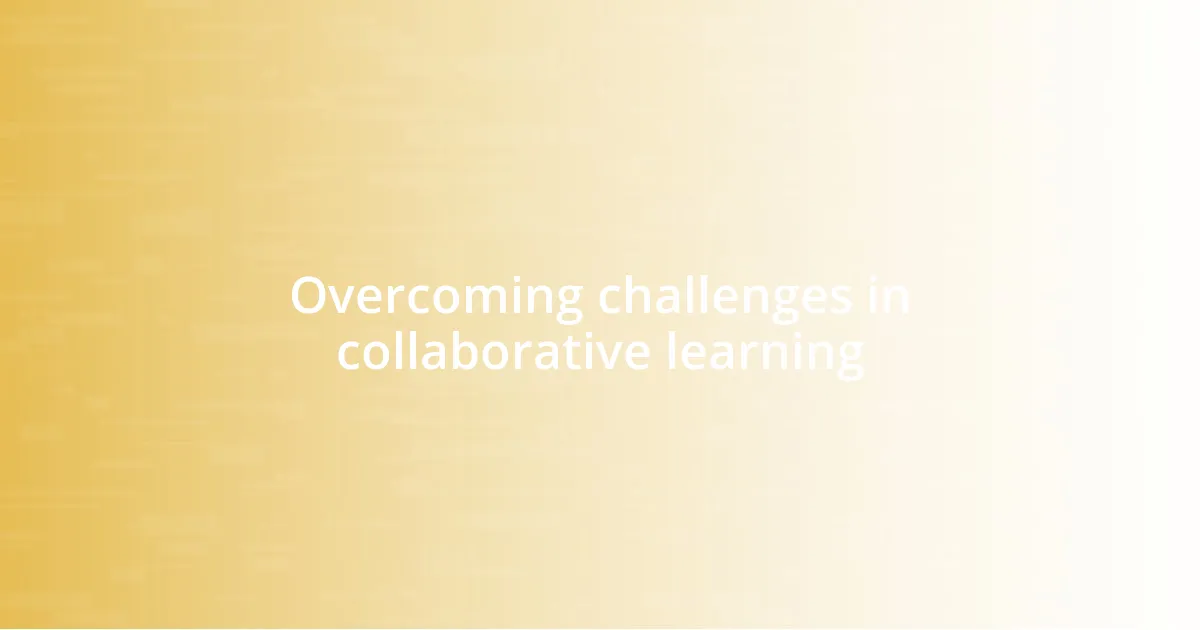
Overcoming challenges in collaborative learning
Collaborative learning certainly comes with its fair share of challenges. I recall a time in a student-led initiative where our differing work ethic styles clashed. It was frustrating at first; some members were diligent, while others often fell behind. Eventually, I took the initiative to bring this up in a group meeting. Surprisingly, it opened up a dialogue. We realized that a quick check-in at the beginning of each session could create a more cohesive flow. Isn’t it interesting how a simple conversation can clarify misunderstandings and improve team dynamics?
Then there’s the challenge of managing conflicting ideas. I once facilitated a discussion where strong personalities immediately dominated the conversation. It felt overwhelming at times. To counter this, I decided to introduce a round-robin format, allowing everyone a chance to voice their thoughts one at a time. This small shift transformed the interaction. Everyone felt heard, and that sense of inclusivity fueled a richer exchange of ideas. Have you ever felt the relief that comes when everyone finally has the chance to participate?
Lastly, I’ve found that trust can be a roadblock in collaborative settings. In a past project, it took time for my group members to feel comfortable voicing their honest opinions. I decided to share an embarrassing mistake I made in a previous project, thoughts bubbling with vulnerability. This moment of honesty broke down barriers and encouraged others to share their own challenges. Once we cultivated trust, our collaboration thrived. It makes me wonder: isn’t it amazing how sharing our flaws can lead to stronger connections and enhanced teamwork?
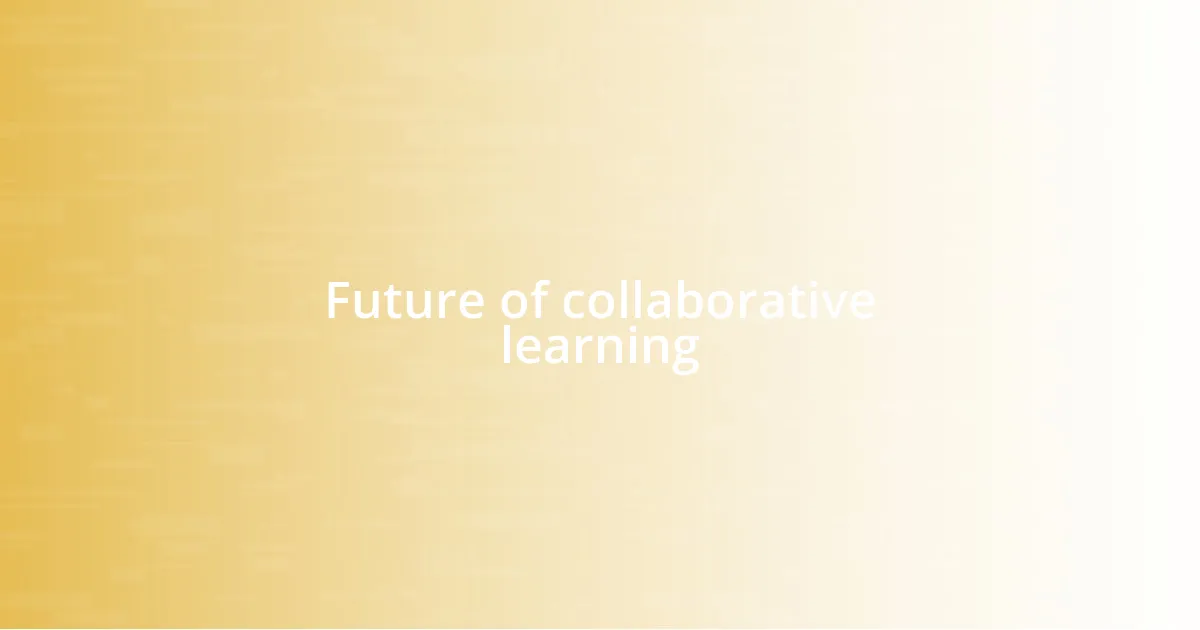
Future of collaborative learning
I see the future of collaborative learning as a transformative landscape, where technology and human connection intertwine. I remember a time when my team experimented with virtual reality for a group project. Stepping into a shared virtual space, we could visualize complex concepts together in real-time. It was thrilling to see how our ideas actually came to life; I found that this immersive experience not only sparked creativity but also deepened our understanding of each other’s perspectives. Have you ever experienced that rush of inspiration when ideas flow in a collaborative setting, amplified by innovative tools?
Looking ahead, I believe that inclusivity will dramatically shape collaborative learning. Reflecting on my experiences, I’ve noticed how diverse groups often lead to richer discussions and results. Once, I was part of an international project team, where each member brought unique cultural insights. The contrast in our viewpoints was initially daunting, yet it evolved into a beautiful tapestry of ideas. Imagine what could happen if we prioritized creating spaces that welcome not just varied opinions, but also the distinct backgrounds of participants. What discussions might unfold if we embrace this enriched diversity?
Another key aspect I foresee is personalized learning pathways within collaborative contexts. It reminds me of a workshop I attended that allowed participants to choose their breakout sessions based on their individual interests. I loved this approach because it empowered each person to connect with others who shared similar passions—sparking more meaningful collaborations. Could you imagine how exciting it would be to combine tailored learning experiences with collaborative projects? By blending personal interests with teamwork, we could unlock new levels of engagement and creativity.










